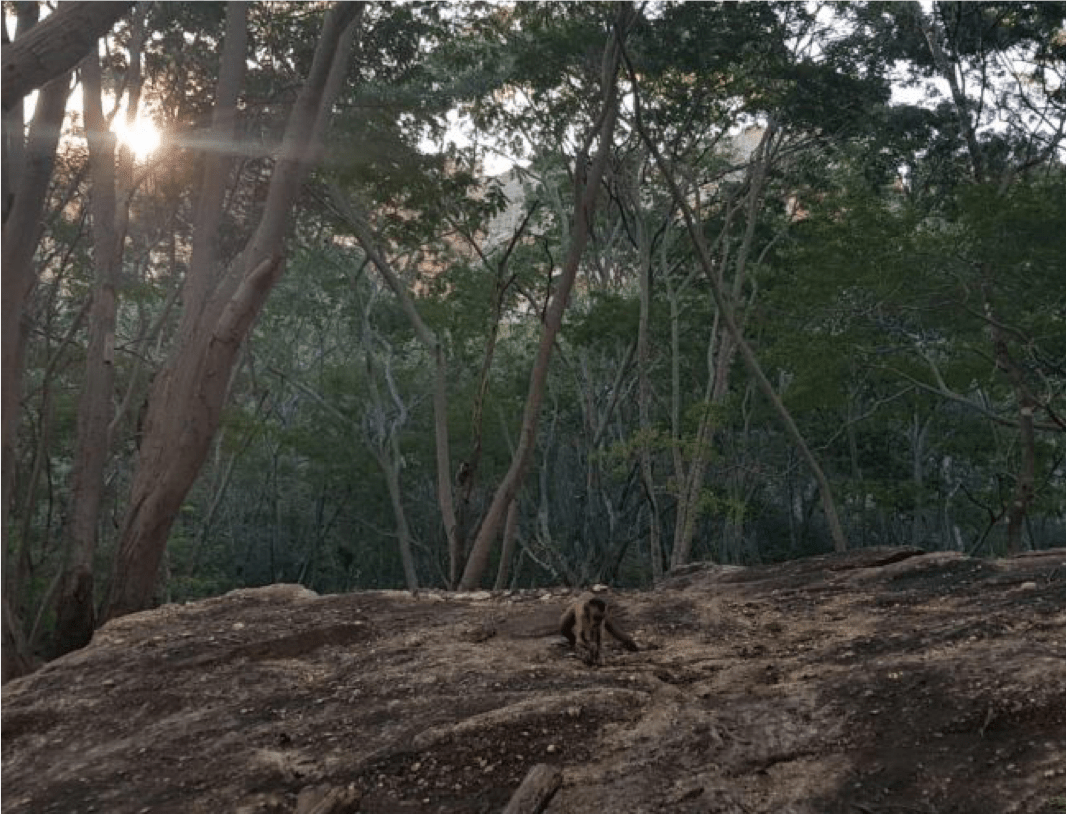Fieldwork Diaries: Elisa Bandini, Serra da Capivara National Park, Brazil.
Elisa Bandini is a postdoctoral researcher at The University of Tübingen working on the cognitive mechanisms behind primate tool manufacture and use. Elisa combines her background in archaeology with current work in primatology and cultural evolution to examine the evolution of early hominin and other primate cognition and culture. She spoke to Cultured Scene about her recent fieldwork trip to Brazil.
CULTURED SCENE: Where was your fieldsite, and what species were you studying there?
ELISA BANDINI: I was studying wild capuchins in the Serra da Capivara National Park in Brazil.

CS: What was the purpose of your fieldwork? What were you studying?
EB: I was working on the stone tool-use behaviour of the capuchins. This was my first time working with capuchins, and I was really blown-away by the extent of their tool-use repertoires. They seem to use stone (and stick) tools for so many different types of behaviours, and they switch so easily between tool types and activities that it was very hard to keep up with them!
CS: What was a typical day in the field for you?
EB: As I was working with wild capuchins, every day was a bit different as it really depended on when (and if!) the capuchins arrived on site. However, a summary of a day in which the capuchins showed up went something like this:
5:30am: Wake-up, eat breakfast, and get ready to head to the site (it took about 40mins to drive from the town of Sao Raimundo, where I was staying, to the site).
7:30: Set-up testing apparatus and wait. Check if the corn we left out last night had been eaten. Add more if it was all gone.
8:30: Walk to nearby site to see if I could find any traces of the monkeys.
9:30: Help Tom (Proffit) & Adrian (Arroyo), two archaeologists, with their nearby excavation as I wait for the monkeys (usually involved being ‘pole monkey’ e.g., holding up the spirit bubble on various artefacts as they took points).
10:30: Monkeys arrive! Two juveniles (which we named Itchy & Scratchy as they seemed to scratch themselves all the time) would often come to the site to eat the corn that we put out for them. They didn’t seem to be attached to a group, but they could have been migrating to a new one.
10.30-12.30: Watch, film and code behaviours as Itchy & Scratchy use stones for various behaviours.
12:30: Quick lunch break when Itchy & Scratchy left the site (we didn’t eat when the monkeys were around as we didn’t want them to associate us with food).
13:40: Big group of monkeys arrive at the site! The big group consisted of around 20-30 individuals, who would all descend on the site together and seemed to do every single tool-use behaviour that I had read about, all at once. Go a bit crazy trying to watch everything and absorb what is going on. Watch, film and code whilst the monkeys are around (they usually stayed for a couple of hours).

17:30: The sun is starting to set and the monkeys have left, so it is time to pack-up, collect the tools the monkeys used that day, bag and label them, and drive home.
18:30: Save all the videos on three hardrives (you can never save enough!), and sort through all the artefacts collected that day.
19:00: Early dinner and stupidly early bedtime to be ready to do everything again the next day!
CS: What have been your best and worst fieldwork moments?
EB: I really enjoyed my time in Brazil, so luckily I can say that there weren’t many bad moments on site. The only thing that I found quite difficult at first was adjusting to the waiting periods. As this was my first time working with wild animals, I had to learn to be patient and wait for the monkeys, and then work around their ‘schedule’ (i.e., when they decided to show up). As I couldn’t bring my laptop to site, and there was no phone reception, let alone Internet access, I struggled a bit with feeling like I wasn’t really achieving anything as I was waiting. However, I started uploading papers to my kindle, so I could catch-up on my reading (which ended up being a really good thing!), and I helped Tom & Adrian on their excavation where I learnt a lot about primate archaeology and we had several interesting discussions on recent developments in our fields.
The best moments were when the big group of monkeys came to site. It was so exciting to see them all, so close, demonstrating all the behaviours that I had read about in papers. I realised then that although working with captive and semi-wild animals is much easier (in that you never really have to wait around), I really enjoyed seeing the capuchins in their natural environment.
CS: If you could give readers one piece of advice on preparing for fieldwork, what would it be?
EB: Always have a plan B! One of the reasons why I had to wait for the monkeys for so long is that the rainy season was going on much longer than usual (good old global warming!), and I didn’t really have a plan B in case they never showed up. This situation was really quite stressful, and I wish I had thought of an alternative solution beforehand, rather than trying to figure it all out whilst I was already in Brazil. Luckily the monkeys did come eventually, and I collected plenty of data, but I would definitely advise everyone going off on fieldwork (whether working with wild or captive animals) to have a plan in case things don’t go as expected (which is usually inevitable when working with animals!).
